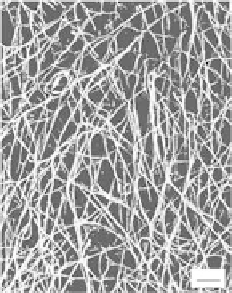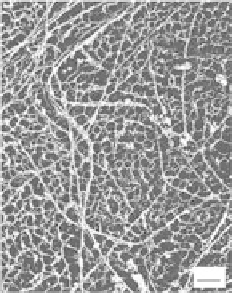Biomedical Engineering Reference
In-Depth Information
1
µ
m
1
µ
m
1
µ
m
(a)
(b)
(c)
Figure9.21
DeepetchfreezefractureTEMofxyloglucan/BCcompositesshowingfromleft
to right (a) absence of crosslinks, (b) intimate mix of thick-stranded cellulose fibrils in a
meshwork of thin stranded xyloglucan and (c) showing areas of thin stranded xyloglucans
between fibrils (67). (Reproduced fromWhitney, S.E.C.; Wilson, E.; Webster, J.; Bacic, A.;
Reid,J.S.G.;Gidley,M.J.,Effectsofstructuralvariationinxyloglucanpolymersoninteractions
with bacterial cellulose. American Journal of Botany, 2006, 93, 1402-14, with permission
fromtheBotanicalSocietyofAmerica,Copyright(2006).)
tamarind xyloglucans the typical crosslinks were observed in all nanocomposites but the
one using 60% galactose depleted xyloglucan. Local alignment of the cellulose fibers was
also observed in all nanocomposites especially with the high molecular weight tamarind
xyloglucans. Besides this aligned and tethered structure, three additional structures were
observed (Figure 9.21).
In one structure, purely cellulosic regions devoid of cross-bridges were observed. This
structure was most prominent in the highly galactose depleted xyloglucan. In another
structure, thin xyloglucan strands appeared interdispersed between thicker and somewhat
aligned cellulose fibers, indicating intimate mixing between the two polymeric phases.
This structure was not seen in nanocomposites using high galactose depleted and/or high
molecular weight tamarind xyloglucans. A last type of structure reminiscent of a weak
gel was observed, indicating large self-association of xyloglucans. This structure was
mainly observed in nanocomposites with xyloglucans having a high degree of galactose
depletion in combination with a pure cellulose domain, demonstrating a high degree of
segregation (two phases) in those nanocomposites. Mechanical properties under uniaxial
loading also showed that the more galactose depleted BC/xyloglucan nanocomposites
had lower strength and extensibility compared to the BC/native xyloglucans. It was
proposed that direct molecular binding between the xyloglucans and cellulose occurred
mainly due to the ability of the xyloglucan backbone to bind to the nascent cellulose
and to adopt the twofold conformation of crystalline cellulose (67). Another important
parameter to molecular binding was the galactose content since high depletion of galac-
tose (60%) led to the development of two phases, a cellulose phase and a xyloglucan
gel phase, a morphology consistent with the low extension and strength observed in



Search WWH ::

Custom Search